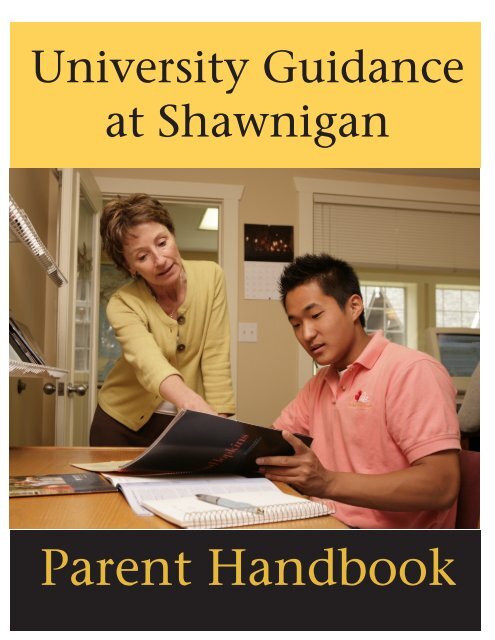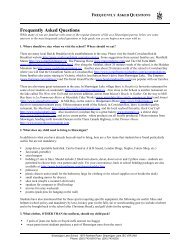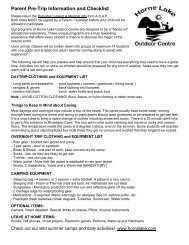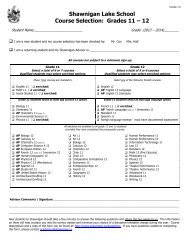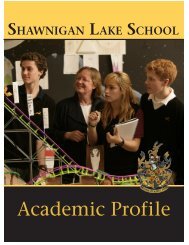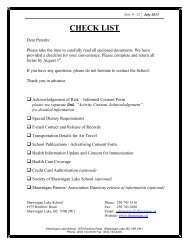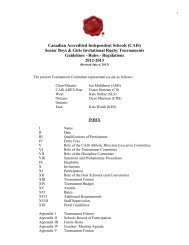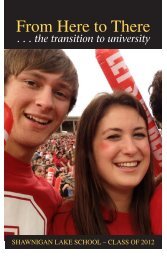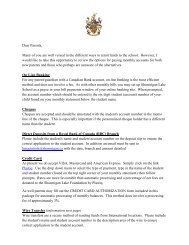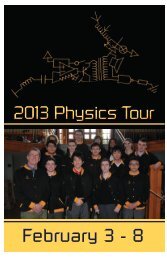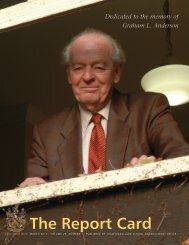Parent Handbook - Shawnigan Lake School
Parent Handbook - Shawnigan Lake School
Parent Handbook - Shawnigan Lake School
Create successful ePaper yourself
Turn your PDF publications into a flip-book with our unique Google optimized e-Paper software.
University Guidanceat <strong>Shawnigan</strong><strong>Parent</strong> <strong>Handbook</strong>
Meet the Guidance Team:Who are we, and what is our focus?leh@shawnigan.caBeth Hall, Canadian and U.S. applicationsjcs@shawnigan.caJohn Sarsfield, Canadian and U.K. applicationsjkingstone@shawnigan.caJim Kingstone, U.S. applicationsdjohn@shawnigan.caDebra John, Planning 10, Graduation Transitionscmacpher@shawnigan.caCindy Macpherson, Transcripts and records
What we do:We are here to provide help to all <strong>Shawnigan</strong> <strong>Lake</strong> <strong>School</strong> students as they explore their post-secondaryoptions and complete their applications.The process starts in Grade 10, when discussion about course selection for upper year classes meansthat students investigate requirements for particular programs of study. In the Planning 10 curriculum,each student begins to assess his or her values and strengths, personality, and learning styleand then formulates a tentative plan for future education. Further research and discussion continuesin Grade 11. Individual appointments are booked with members of the guidance team in Grade 11and Grade 12. In these meetings, students are guided through a process of self-evaluation that helpsto highlight strengths, possible fields of study and the choice of learning environment. Work thenfocuses on the match between the student and the university or college.Once we have decided on the “where and what,” we start considering the “how and when.” Helpwith the application process is provided every step of the way. We meet with students individuallyand in small groups, to make sure applications are completed in a timely and accurate manner. Wehave expertise in assisting students applying to universities in Canada, in the U.S. and in the U.K.Our office uses the Naviance on-line programs to manage data in the counselling office and providesupport for the students.What is Naviance?At <strong>Shawnigan</strong> <strong>Lake</strong> <strong>School</strong>, we use a web-based resource called “Naviance” to support our work withstudents as they plan their post-secondary ventures.Students in Grade 10, 11 and 12are introduced to different aspectsof Naviance to help with theirresearch and their applicationwork. Through this site, studentscomplete a personality profile, alearning styles inventory and gradespecificquestionnaires that help usguide them in appropriate directions.They research institutionsthrough the Naviance database andkeep a list of interesting options.<strong>Parent</strong>s are also able to access “FamilyConnection” on Naviance andfind information about universitiesworld-wide, as well as specific resources we have posted from the school.To access Family Connection as a guest, go to: www.connection.naviance.com/shawniganand use “shawnigan” as a password.2
The College Process in Chronological Order:3SeptemberOctoberNovemberDecemberJanuaryFebruaryGrade 11 Grade 12All Grade 11 students are invited to attend Appointments begin with the Guidance team to discussvisiting university seminars held throughout the plans and create a timeline. Students and faculty use thefirst term.Naviance program to track progress.Students attend university information sessions at SLS –ongoing throughout the fall.Students who are considering applying to U.S.universities write the PSAT.This is the busiest month for university visits toSLS.CUE (Canadian University Event) is held at SLSin November, bringing together 40 Canadianinstitutions for an information fair.Results from the PSAT are sent to the school anddistributed to students.Some Grade 11 students opt to write the SAT (atSLS) at this time if they feel prepared.Possibility of a university tour to Ontario andQuebec, depending on interest.March Group and individual meetings for Grade 11students begin with the Guidance team andcontinue through the spring. Grade 11s areintroduced to the Naviance on-line program tohelp with their exploration and later with theirapplications. They complete the Grade 11questionnaire and the “Do What You Are”personality test on-line.April SAT prep course provided at the <strong>School</strong> by anoutside consultant.May May SAT if requested (not at SLS)By this time, students should have a long list ofschools they are interested in exploring in moredepth.Workshops are held for students needing to writepersonal statements for their applications (U.S.and U.K. applications only).June June SAT if requested (at SLS)Application workshops held for students applyingto U.S. and U.K. universities.Summer Students continue their research (and campusvisits if possible) to narrow their selection ofschools. U.S. applications should be done in draftform. Students applying to Oxbridge or UKmedical schools need to have the application wellunderway in the summer.SAT prep course provided by outside consultant.October SAT for applicants to U.S. universities.Oct 15 deadline for Oxford or Cambridge applicants andUK medical schools (note: Oxford requires application bySept 20 if students wish to book interview in Vancouver)November SATDeadline for Early Decision applicants to the U.S.Most university visits to SLS completed this monthApplications started to Canadian universities.Ongoing discussions with the Guidance team.December SAT at SLSRegular Decision U.S. applications completed and sentthis month.Remaining UK applications submitted.Work on Canadian university applications continues.Notification of U.S. Early Decision mid-month.January SAT at SLS – some US universities will acceptthis test as the last opportunity to submit scores.Review of university plans and adjustments made ifnecessary based on first term results.Remaining Canadian applications submitted.Grade 12 students may choose to take time over Ski Weekto visit campuses or do other things related to their postsecondaryplans.Mid-year reports with marks sent to many universities.Campus visits encouraged if not already made.Students self-submit marks to some Canadian universities.A few Canadian universities will admit students at thistime.Many U.S. colleges announce admission decisions.More Canadian universities send offers of admission.Admission offers accepted or declined by studentsCourse registration opens for some Canadian universities;students are assisted in this process.Final details are attended to regarding deposits, residence,course registration, etc.Final transcripts are sent from the Ministry of Education tostudents, along with graduation diplomas (the DogwoodDiploma).Transcripts are also sent to those universities and collegesthat students have decided to attend.
The application process: in Canada• Canada offers a host of exciting opportunities for post-secondary study. From small, rural campuses to large,urban universities, there is a choice to fit every need.• Post-secondary choices include universities, technical schools, art colleges and community colleges.• Admission to Canadian universities normally depends on the results students achieve in Grade 12.• On occasion, a supplemental form is required, but many programs admit students on the basis of theirgrades alone.• An admission average is determined by each institution, using marks they are sent mid-year. Most universitieswill use 4 or 5 academic grade 12 subjects, including English, to calculate the average.• Offers of admission are normally conditional, based on final results.• Provincial exams are not needed for Canadian universities (other than Concordia), though provincially examinablecourses are often required.• Requirements vary from institution to institution and we provide help in determining the Grade 12 coursesthat are best to take.Student responsibilities:• Beginning in Grade 10, students should start to research their options.• Ask questions, check web sites, visit campuses, find out what is offered and where.• In grade 11, work with the guidance team to develop a list of possible opportunities.• Refine this list in the fall of Grade 12 in preparation for applications.• Know what is required in terms of marks and any supplemental information.• Keep a file. Be organized.• Read emails regularly to stay in touch with the guidance office. Attend any scheduled meetings.• Complete applications forms on-line in the guidance office so we can check your submissions.• Be aware of residence applications, check deadlines for applications and deposits.• Read ALL correspondence from universities. If you are confused by anything, bring it to our attention immediately.How we will help:• Meet with students in small groups and individual appointments.• Help students determine appropriate choices for university and college based on interests, courses, schoolrecord and location of choice.• Remind students of deadlines as they come up.• Assist with the application process and arrange payment of application fees if necessary.• Remind students to complete residence applications.• Help students understand the correspondence sent from universitiesWhat parents can do:• Encourage your children to explore as many options as possible to help them find the best fit.• Visit campuses if you are able.• Ask questions when you talk to your children so you understand where they are in the process and what supportthey might need from you.• Communicate with the guidance team whenever you have questions. We welcome your input.For more information:www.pas.bc.ca www.ouac.on.ca www.schoolfinder.com www.canlearn.ca4
The application process: in the United StatesA student looking to exercise educational options outside of Canada may choose to look south of the border andapply to American schools. With 3600 colleges and universities to choose from, the possibilities are almost limitless.Our students typically, however, confine their search to about fifty of the better known schools, some of whichhave highly selective admissions criteria. To successfully negotiate this complex process requires careful planningand organization, and students are urged to begin the process in their grade 11 year.A feature of this process includes applying to schools specializing in what is called the liberal arts. A liberalarts education is devoted to training students how to think, rather than for a specific job or career. For studentsunprepared to declare a specific area of interest; for students who wish to remain open about their options; and forstudents who wish simply to explore a variety of possibilities untrammeled by the restrictions of course requirements,the liberal arts provide a compelling opportunity for intellectual and personal growth.Student responsibilities:• Start researching your options early.• Sign up to write the PSAT in October of your Grade 11 year. Be aware of SAT test dates and register in a timelymanner. Plan ahead which tests you need to write and when you will write them.• Attend any group sessions offered to help you with the application process, then book individual appointments.• Meet with the guidance team to discuss your choices and plan your applications – what will you write in yourpersonal statement? who will write your references? how will you present yourself?• Be aware of deadlines and meet them with time to spare. Work done at the last minute is seldom your best. Itis expected that much of the work will be completed before you return to school in September of Grade 12.• Request references well ahead of when they are needed; allow at least 3 weeks.• Keep us informed of where you are in the process so we can provide the help you need.• Read everything you receive and ask for clarification if you are confused.How we will help:• Meet students in group sessions and individually to help with research and application tasks.• Provide feedback on colleges of interest and suggest alternatives where we feel appropriate.• Offer writing workshops to help students craft powerful personal statements• Work with teachers to focus on strong letters of recommendation• Present your transcript and school recommendations in the best way we can to support your applications.What parents can do:• Your children will need your support through the complex work of applying to U.S. universities.• Visit as many colleges as possible to help them refine a list of colleges.• Encourage students to finish rough drafts of applications in the summer before they return to school for theirfinal year.• Read their personal statements and provide feedback. They will also do this at school, but your opinion offersanother chance for reflection.• Offer to work with them when they are home to complete some of the detailed forms together.• Keep in touch with them so you know where they are in the process and what needs to be done.• Feel free to call or write the Guidance Office to ask questions.For more information:www.collegeboard.com www.commonapp.org www.petersons.com www.usnews.com5
The application process: in the United KingdomIn the last few years, <strong>Shawnigan</strong> has experienced an increasing interest in university attendance in the United Kingdom.There are several reasons for this: students are much more aware, through electronic media, of the opportunitiesthat exist outside the boundaries of Canada; we have a more eclectic body of students who wish to broadentheir horizons; students realize that they can begin their careers, particularly in the veterinary, medical, legal anddental professions, at an earlier age; and , in the increasingly intertwined global economy, parents may wish tohave their children exposed to that wider world.• Admission to UK universities normally depends on results obtained in Grade 12, a personal statement, and aletter of recommendation. It may be helpful to submit, at some universities and in some programmes, S.A.T.and/or Advanced Placement results.• For some programmes, at some universities, a supplemental form and/or additional testing and possibly aninterview may be required.Student Responsibilities:• Because the UK is a distant destination for university, students must very thoroughly consult web-sites. TheUniversity and Colleges Admissions Service (UCAS) is an absolutely vital tool for prospective students to theUK to master. It is not too early to begin this process in grade 10!• If possible, visit campuses!• In grade 11, work with the guidance team to develop a list of possible opportunities.• Because the deadlines for Oxford and Cambridge universities, and for veterinary medicine, dentistry andmedicine are early in October, it is CRITICAL FOR STUDENTS TO COMPLETE THIS WORK IN THE SUMMERBEFORE GRADE 12, if those programmes/universities are of interest!• Refine and prepare applications for UK universities in the early days of Grade 12.• Know what is required in terms of supplemental information AND THE DEADLINES FOR IT!• Be organized! Keep a file!• READ EMAILS REGULARLY! Stay in touch with the Guidance Office. Attend scheduled meetings.• Read ALL correspondence from universities. If you are confused about anything, bring it to our attention immediately.Don’t leave issues to the last minute!How we will help:• Meet with students in small groups and, particularly, individual appointments.• Help students determine choices based on interests, courses, school record and location .• Assist students who wish to attend Oxford or Cambridge make strategic choices regarding programmes and colleges.• Help students with personal statements and teacher recommendations.• Remind students of deadlines.• Assist with the application process and arrange payment of application fees if necessary.• Help students understand correspondence sent from universities.What parents can do:• Encourage your children to explore as many options as possible to help them find the best fit.• Work with your children to COMPLETE applications to Oxford, and Cambridge universities, or applications toANY UK university for medicine, veterinary medicine or dentistry IN THE SUMMER PRECEEDING GRADE 12.• Visit prospective UK university campuses if possible.• Consult regularly with the guidance office whenever you have questions.For more information:www.ucas.com and Google: Guardian University Guide and Times University Guide6
Scholarships and Financial Aid:(information for Canadian institutions)Entrance Scholarships• Scholarships from colleges or universities and available to high school grads are known as entrancescholarships.• Some awards are dependent solely on marks (eg. UVIC requires 85% for an entrance award of $1000, McGillrequires a minimum of 95% over grade 11 and 12 for $3000). Students are automatically considered for theseawards and a separate application is not required.• Major entrance scholarships normally require a nomination from the school and are based on marks,community service, school activities, references and leadership. Very selective. Expect marks to be in the lowto mid-90s to be competitive and a resume rich with leadership and service activities.University Affiliated Scholarships:• These are scholarships given to students at a particular university, and dependent on an affiliation withan organization, geographical region, professional association, club or program. Check university web sitesfor details.Other Scholarships:• Scholarships may be awarded by businesses or organizations (eg. Wendy’s, ReMax, Royal Canadian Legion,etc.) for post-secondary study. These awards often stress community involvement before academic results.• Many of the most prestigious scholarships (eg.TD Canada Trust Scholarship for Outstanding CommunityLeadership, Loran Award, etc.) have a strong community service or leadership component to them. Applicantsare reviewed on the basis of their contributions to the larger community, as well as their academic promise.It is more than achieving good marks – these scholarships are looking for applicants who take initiative andmake a difference.Government Awards:• Provincial Scholarships are awarded on the basis of the provincial exams. Students must earn a minimum of aB in English and 86% or more on three provincial exams to receive $1000.• Dogwood District/Authority Awards Program. A scholarship of $1000 may be awarded to students for excellencein a non-academic field (eg. fine arts, phys. ed.) Students need to be pursuing studies in their chosennon-academic area and submit samples of their work for adjudication.• Passport to Education: sponsored by the Ministry of Education and awarded on the basis of academic and nonacademiccriteria. A limited number of these awards are available to each school. Value up to $1000.B.C. Student Assistance Program:• B.C. Student Loans and Canada Student Loans• Loans are given to students using a formula that assesses parental income less expenses to determine theamount of money that might be available. http://www.aved.gov.bc.ca/studentaidbc/Bursaries:Bursaries are available at universities and colleges on a financial need basis. Most bursaries require that students applyfor a student loan before a bursary is granted.For more information:http://www.studentawards.comhttp://www.scholarshipscanada.com/


